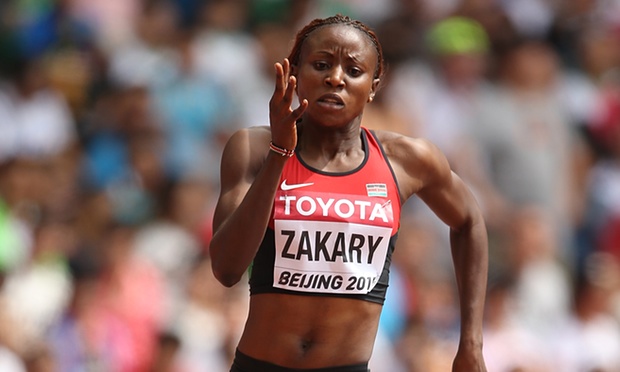As it became clear that Julius Yego’s javelin was soaring across nearly the entire length of the Bird’s Nest pitch, and nearer than anyone else to the large scoreboard near the end of it, there were 50,000 gasps of astonishment. But the sight of Yego’s country, Kenya, being way out in front of the medal table at these world championships with six golds, three silvers and two bronze medals is likely to cause an even greater surprise. Startlingly, after five days, those traditional athletics superpowers, USA and Russia, have only one gold medal between them.
But while Kenya revels in its triumphs, it is also having to face up to its problems. Around 40 of its athletes have tested positive for drug use in the past two years, and two more were added to the roll of shame on Wednesday when it was revealed that the 400m runner Joyce Zakary and 400m hurdler Koki Manunga had both agreed to provisional suspensions after failing pre-competition tests.
As Evelyn Watta, the Kenyan journalist who broke the story, puts it: “Initially when our athletes were first linked with doping in 2011 and 2012 the initial reaction was no, it’s a lie – there is no doping in Kenya,” she says. “But now we are more mature. And there’s a sense of if there’s something wrong, Athletics Kenya and the Kenyan government need to make sure the bad apples are removed. It is not denial, denial, denial.”
However it is tricky to gauge the full extent of the problem. Most of the athletes caught have been below the super-elite level. There are many possible reasons for that, but the most straightforward is that even a decent Kenyan runner could have his or her life wildly changed by winning a few modest races and getting spotted by a scout – so the incentive to cheat is high. As the BBC’s Steve Cram puts it: “Athletics is the sport in Kenya and they’re prepared to do whatever it takes. They need educating and we need to attack it at a cultural level as well as with testing.”
Advertisement
But David Rudisha’s coach, brother Colm O’Connell, believes it would be too simplistic to see the rise of Kenyan athletics in Beijing – including in new events such as the javelin and the 400m hurdles, which was won by Nicholas Bett on Tuesday – as something necessarily sinister.
“If you look back in the 1970s and 80s we had sprinters who were formidable,” he says. “Then there came a big lull because all the agents and coaches naturally showed an interest in the long-distance runners. These days it is hard for sprinters in Kenya because of the lack of coaching and facilities, but someone like Bett comes from a part of Kenya that is known down through the years for producing hurdlers, so it is not a big surprise in that sense.
“The fact Bett and Yego have been able to use YouTube to learn how to do their events is interesting too, because it shows how technology can also help athletes in events where coaches aren’t around.”
Some were surprised that Bett went from finishing fifth in the opening heat of the Commonwealth Games last year in a time of more than 51 seconds, to winning gold in Beijing in 47.49. But Watta is less suspicious. As she points out, he had no coach until he was spotted by the South African Hennie Koetze this time last year, so was always going to improve once he improved his rudimentary technique and training.
It is also worth remembering that, despite the successes of Yego and Bett, most of Kenya’s success is still at middle- and long-distance running, where they may possess genetic and environmental advantages.
As David Epstein, who spent a lengthy period in Kenya for his book The Sports Gene, points out, one tribe – the Kalenjin – make up only 12% of Kenya’s population, but the vast majority of elite runners. “To put Kalenjin distance running success in perspective, 15 Brits have broken 2:10 in the marathon in history, while 32 Kalenjin did it in one month in the year I was there,” he says.
Advertisement
“One reason that Kalenjin runners will continue to be overrepresented has to do with physiology. They have their ancestry at very low altitude in a very hot and dry climate. People with that ancestry tend to have long limbs relative to their body size with very narrow outer extremities. This is an evolutionary adaptation for cooling. And because the leg is like a pendulum, the longer it is and the less weight there is at the outer end, the more energy-efficient it is to swing.”
As Epstein explains, in one study, runners who had to wear eight pounds of weight on their waist expended 4% more energy to run a given pace. When the weight was shifted to their ankles, they burned energy 24% more rapidly.
Running huge distances at a young age at altitude also helps. Yannis Pitsiladis, a scientist who has studied east African runners, found that the longer the distance a Kalenjin runner competed in, the more likely they were to have had a long run to and from school during childhood.
But can we expect Kenya to build on their success in Beijing in the future? Brother O’Connell is not so sure. “Success in the field will make young people aspire to that and those events,” he says. “But I’m always a bit cautious about world champions before Olympic Games. Kenya did well in Daegu in 2011, remember, but at London 2012 the Ethiopians stepped up.”
Meanwhile Epstein, while urging Kenya to face up to its doping issue, says it does not appear to be a huge outlier as a country. “The Sunday Times/ARD report noted that 18 Kenyan medals at world championships or Olympics were won by athletes with at least one suspicious blood value,” he says. “Kenya won 92 medals during that period, which would put Kenyan medallists pretty well in line with athletics overall in terms of the proportion of suspicious values, and would make them much less likely than non-Kenyan medallists to have had suspicious blood values.”
Even so, Wednesday’s failed tests are not a good look. Especially for a country on top of the medal table.










